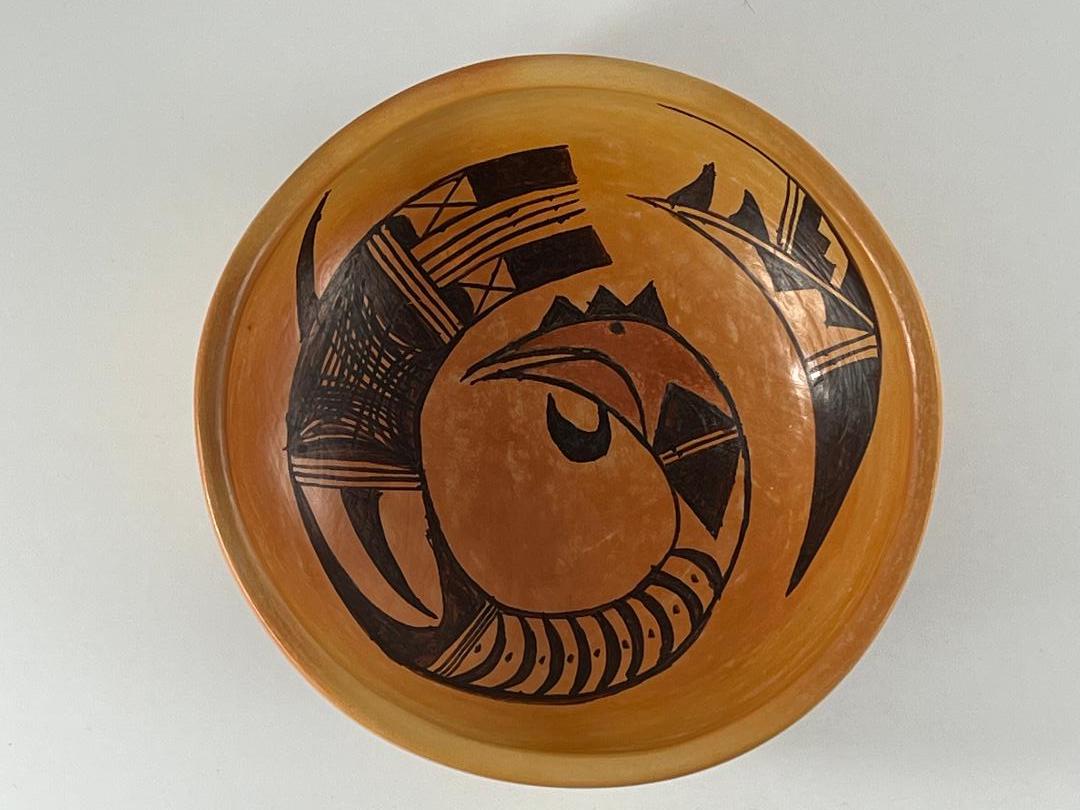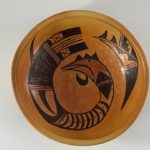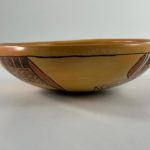I am greatly enamoured of pottery by Rachael Sahmie and this have more pots by her than by any other potter, with the exception of Nampeyo. Seven generations of Nampeyo family pottery are included in the collection and I am always on the lookout for pottery by younger members of the family (cf 2009-21 and 2013-20. Also 2009-22 and 2013-19).
Thus I have been particularly interested in obtaining a pot by Rachael’s daughter, Carla Talashie, should she ever make any. Her mother tells me Carla last made pottery when she was seven. Now she is well into a career in the Army, has two young children, and was stationed overseas and at various locations in this country. Thus she had little time, opportunity, or perhaps interest in making pottery. Within the last couple of years, however, Carla (still in the army) moved to Phoenix, about a 4-hour drive from her Mom. Much to Rachael’s pleasure Carla began making pottery, her first since she was 7. Bowl 2021-06 was part of the first batch she fired.
Form:
The bowl is somewhat thick for its size, as one would expect of an artist learning to work with clay. The top edge of the pot has fairly sharp corners, as if the clay had been cut flat with a knife.
Design, Interior:
The central design on the interior is a 10-inch long creature curled into a 4-inch wide circle. Its red head has a long beak, the mouth slightly open. On top the head grows an three-pointed triangular crest, just below is the black dot of an eye. A thick, curved black shape grows out of its lower jaw, perhaps a wattle. Set into the base of the head is an equilateral black triangle, its base set against three parallel lines, a “two lane highway” that was often used by Nampeyo to segregate sections of her designs. What follows is another equilateral black triangle so that the two triangles on either side of the highway are mirror reflections. A 2.5-inch section follows, decorated with nine black half-moon elements, perhaps the scale segments on this reptilian creature. Each segments carries a black dot. Then the body widens to a section of design displaying “foreground/background reversal,” where the foreground and background keep changing places. This section can be seen as solid black with the intrusion of an unpainted arch with blunt ends based on the far wall. Alternatively, the section can be seen as largely unpainted with the intrusion of a black arch with narrowing sides and pointed ends based the far wall. Almost filling the center of this black arc is a black tooth-like element with slightly curved sides. A viewer’s eye shifts between these alternative ways of seeing this section.
Following a set of four parallel lines (a three-lane highway) is a less-precisely drawn segment. Based against each of the four wall of this space are low hill-shaped elements painted with a very dark maroon, muddy, paint: perhaps a mixture of the red and black paint found elsewhere in the design. Carla then drew fairly straight lines at right angles to each other across the empty center of the space, then fairly randomly sketched in 15 lines across the body of the creature and about 12 lines at cross angles. Off the top edge of this section is a long black fin. Following another three-lane highway are two sets of tail elements. The flanking tails begin with a solid black “gumdrop” based on the highway, followed by a largely unpainted section containing a thin black “X,” that is caped with a solid black rectangle. Between these substantial flanking tails is a set of three parallel lines, also part of the tail plumage.
While portraiture is not common on pots made at Hopi, variations of this reptile are among the most popular portraits drawn. For similar creatures see pots 2005-05 and 2005-06.
The reptilian creature is painted off-center of the interior. In the unused space above its head is an incomplete sketch of an avian form. A solid black head is based on a two-lane highway. Behind is a two-inch space with a open end. Two parallel lines running from upper right to bottom left form a diagonal. Two conjoint black equilateral triangles are attached to the lower surface of this diagonal and project into an otherwise unpainted surface. Background/foreground reversal allows this design to also be seen as three conjoint unpainted peaks rising from below into a black background, sort of a white mountain range at night. The area above the one-lane highway diagonal is divided by a two-lane highway at right angles to the diagonal. The section above contains a small black triangle in its upper corner and a black two-step kiva/rain-cloud set against the rear wall. Alternatively (background/foreground reversal), this section can be seen as all-black with an unpainted two-step kiva/rain-cloud element based on its upper edge. Below the two lane-highway two black-tooth shapes are based on the diagonal. Perhaps because this section is open-ended, the expected background/foreground reversal in this last section is not apparent.
Design, Exterior:
Central band:
The exterior has a single thin framing line a fraction of an inch below the lip that required several strokes of a brush. The exterior is fully designed, with patterns at cross angles to each other. One pattern is a central symmetric band that spans the width of the bowl and is bordered by two parallel lines, one-lane highways. Four two-lane highways cut across the width of this band, cutting the into 5 segments of design. In the central segment is a black-edged, brown-stippled, rectangle floating in an unpainted rectangle. The segments on either side house a thin black crook with four 90-degree turns. One rendition seems painted with a seamless line, the other rendition required several strokes with a brush. The next segments to toward the rim of the bowl are simple unpainted areas crossed by thin lines in the form of an “X.” Finally the design segments nearest the rim contain two parallel rectangles that have been filled in to represent feathers. Their base is a black lunette (“gumdrop”) followed by a brown-stippled section and ending with a black, rectangular tip.
The remaining designs on the exterior are substantially wider that those in the central band. If we arbitrarily label one side of the central band as “above” the band and the other as “below,” the designs “above” the band are quite different than the designs “below,” though each set is internally symmetric.
Below the band:
“Below” the band the core of the design is formed by two segments that reach from the center of the center of the bowl to the rim. The first segment is a black-edged square containing two kiva/rain-cloud elements with 4 or 4.5 steps each, the four-step version smaller than its neighbor. The short edge of four-step rendition extends across empty space and intercepts the second rain cloud, cutting its lower step into large and small segments, hence the 4.5-step characterization. The short edge of the 4.5-step rain cloud also extends across the segment, but misses its neighbor and then turns sharply to the right between the 4-step cloud element and the edge of the segment. The base of this 4.5-step rain cloud merges with a wide black band that separates this segment from the next.
Set against this black band in the next segment is an unpainted dome-shaped form with three parallel lines crossing its apex. Much of the rest of the space in this segment is filled with brown stippling that separated into four rectangular shapes along its far edge. Each stippled segment is caped with a muddy-black square tip that end at the framing line, thus completing the image of four parallel feathers. Exterior to this portion of the design are red lunettes, their bases proportional to the segment they adjoin.
As this below-the-band design intersects the central band of design, it is flanked by additional designs: first an equilateral triangle with a triangular crook hanging from its apex, next an additional red lunette with its base parallel to the central band of design.
Above the band:
Above the central band of design, Carla has drawn three concentric single-line arches with their bases fixed to this band. Internal to the small central arch Carla has placed three black lens elements forming a linear doorway. The space between the first and second arch is left largely empty, except at the apex where she has drawn a bifurcated arrow shape formed from small lunettes and lenses. Between this second arch and the third (which is part of the framing line), is a empty space, itself a residual arch shape, with wide feet and a thinner apex. This space is painted red.
Design Analysis:
As can be seen from the length of my description of the interior and exterior decoration, the painting on this bowl is complex. Because it is decorated both inside and out, the bowl is unsigned. However Rachael mailed it to me with a note (on file) that reads:
“Craig: Here’s the pot. Thank you. I am so excited that Carla is making pottery & you have one of her starting pieces. Your friend, Rachael”
For a “starting piece” of pottery, the design is very ambitious. There is a lot of design effort on this small bowl. Her brush work is not a smooth as you might expect of a more experienced potter, another way to say that I am delighted to have one of Carla’s early pots in this collection. The interior design is constrained by the animal motifs they depict, while the exterior design has less structure. On the exterior Carla seems to be playing with a variety of elements and patterns to see what satisfies her. I will be interesting to see what she discovers as she gains experience. Should she continue to make pots, she might some day be teaching her son or daughter to make beauty from clay. What a pleasure it would be to add pots by another creative generation of Nampeyo potters to this collection.




